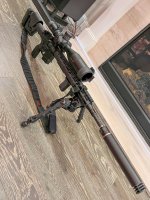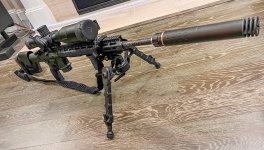First off, I’m sorry this got so long, I edited and edited but could not get it much shorter.
I finally got to stretch the legs on my BadRock 6mm ARC last weekend. The plan was to start at 100 yards to recheck zero, then go to 200 – 300 and 600. Unfortunately, I could not test it past 300 yards because the range had a match going at the 600-yard line.
I figured I’d still run it to 300, I wanted the data, and even more so because everyone must qualify a new rifle/scope combination at that distance (max 2-MOA) to move to the long-range 600+ line (long story). No issues for me there. I qualified easily under 1MOA. A 3-shot subgroup out of a .9 MOA 5 shot group at 300-yards with a wicked 4 o'clock wind, not strong but big swings 0 -10 gusts, measured .217 MOA when the wind settled at my dialed in 4mph.
Pic at the end.
I’ve been using the Hornady 4DOF phone app because I don’t reload anymore, and their 6mm ARC 108 Match is in the database. Being old school, ok just old, I’ve always used zero range with a velocity estimate, no chrono, figuring to do a velocity adjustment at 300 yards and BC corrections over 600. But, I’m always open to new things - 4DOF.
I use a cheap weather meter that connects to my iPhone and then transfer the environment stuff manually, although it will connect to the 4DOF app. It’s not very accurate compared to my Davis home weather station but it’s close enough for ballistics.
Not fond of Kestrels with their tiny 1980’s LCD screens and for that reason alone I think they are highly overpriced. Well, also because they charge ~$60 extra for a Bluetooth “Link” option. I check often and so far they don’t offer anything under $350 or so with “Link”.
The Short Summary:
That was a mistake. Close enough at 100 or 300 doesn’t cut it, as I found out. I’m talking accuracy now, not hits on steel which are a lot more forgiving.
So, in comes Zero Angle. I had all this new data, including wind and environmental so when I got home with all the targets, I decided to try Zero Angle. That started with re-examining (averaging) my 100-yard 5-shot groups from earlier in the day to find the the required average windage and elevation for Zero Angle.
That was the first clue. Even though I had a good number of bullseye height hits at 100, the real average was .2 inches low – less than .1 mil so I had earlier dismissed that. And as I learned this weekend, that small error at 100 can make a large difference at longer ranges. I corrected that.
So, I got Zero Angle up and running. Once done, I went back to the 300-yard come up on the app and it was LOW AGAIN! That was the revelation. I had changed my velocity to 2750 remember? I changed the velocity back to the original 2800 and everything matched my targets perfectly! So, as of now, it seems that my 26-inch barreled 6mm ARC is a 2800 FPS rifle. And as always, “seems” is the qualifier. And also, I don’t necessarily trust chronos because I have no way to verify them. Bullet impacts tell the truth. Everything else is somewhat unverifiable. I have no interest in chasing invisible marketing monkeys.
If your bullet is in the 4DOF database I would really consider giving Zero Angle a try. It worked for me – so far. Will let you know after shooting at 600+. Whichever way you do it though, it is critical to get a true, honest, and accurate 100-yard Zero Range over a number of iterations first, and then average them. That unless you’re related to Annie Oakley – I’m certainly not!
300-yard target with measured subgroup:

I finally got to stretch the legs on my BadRock 6mm ARC last weekend. The plan was to start at 100 yards to recheck zero, then go to 200 – 300 and 600. Unfortunately, I could not test it past 300 yards because the range had a match going at the 600-yard line.
I figured I’d still run it to 300, I wanted the data, and even more so because everyone must qualify a new rifle/scope combination at that distance (max 2-MOA) to move to the long-range 600+ line (long story). No issues for me there. I qualified easily under 1MOA. A 3-shot subgroup out of a .9 MOA 5 shot group at 300-yards with a wicked 4 o'clock wind, not strong but big swings 0 -10 gusts, measured .217 MOA when the wind settled at my dialed in 4mph.
Pic at the end.
I’ve been using the Hornady 4DOF phone app because I don’t reload anymore, and their 6mm ARC 108 Match is in the database. Being old school, ok just old, I’ve always used zero range with a velocity estimate, no chrono, figuring to do a velocity adjustment at 300 yards and BC corrections over 600. But, I’m always open to new things - 4DOF.
I use a cheap weather meter that connects to my iPhone and then transfer the environment stuff manually, although it will connect to the 4DOF app. It’s not very accurate compared to my Davis home weather station but it’s close enough for ballistics.
Not fond of Kestrels with their tiny 1980’s LCD screens and for that reason alone I think they are highly overpriced. Well, also because they charge ~$60 extra for a Bluetooth “Link” option. I check often and so far they don’t offer anything under $350 or so with “Link”.
The Short Summary:
- A really accurate 100-yard zero range is super critical. A couple of tenths of an inch off at the 100 zero can make a big difference at longer ranges. And the problem is compounded because I miss some shots outright, and then most scopes only adjust in .36- or .25-inch clicks. Zero Angle takes care of those adjustments for you at long range.
- Using Zero Angle made everything work perfectly to 300 yards – so far.
- Due to internal ballistics differences in rifles over 600 4DOF uses Coaxial Factor (drag calculation) – not BC. That’s untested by me but it seems to work using the same principles as Zero Angle so I’m cautiously optimistic.
- Garbage in Garbage Out!
That was a mistake. Close enough at 100 or 300 doesn’t cut it, as I found out. I’m talking accuracy now, not hits on steel which are a lot more forgiving.
So, in comes Zero Angle. I had all this new data, including wind and environmental so when I got home with all the targets, I decided to try Zero Angle. That started with re-examining (averaging) my 100-yard 5-shot groups from earlier in the day to find the the required average windage and elevation for Zero Angle.
That was the first clue. Even though I had a good number of bullseye height hits at 100, the real average was .2 inches low – less than .1 mil so I had earlier dismissed that. And as I learned this weekend, that small error at 100 can make a large difference at longer ranges. I corrected that.
So, I got Zero Angle up and running. Once done, I went back to the 300-yard come up on the app and it was LOW AGAIN! That was the revelation. I had changed my velocity to 2750 remember? I changed the velocity back to the original 2800 and everything matched my targets perfectly! So, as of now, it seems that my 26-inch barreled 6mm ARC is a 2800 FPS rifle. And as always, “seems” is the qualifier. And also, I don’t necessarily trust chronos because I have no way to verify them. Bullet impacts tell the truth. Everything else is somewhat unverifiable. I have no interest in chasing invisible marketing monkeys.
If your bullet is in the 4DOF database I would really consider giving Zero Angle a try. It worked for me – so far. Will let you know after shooting at 600+. Whichever way you do it though, it is critical to get a true, honest, and accurate 100-yard Zero Range over a number of iterations first, and then average them. That unless you’re related to Annie Oakley – I’m certainly not!
300-yard target with measured subgroup:

Last edited:



